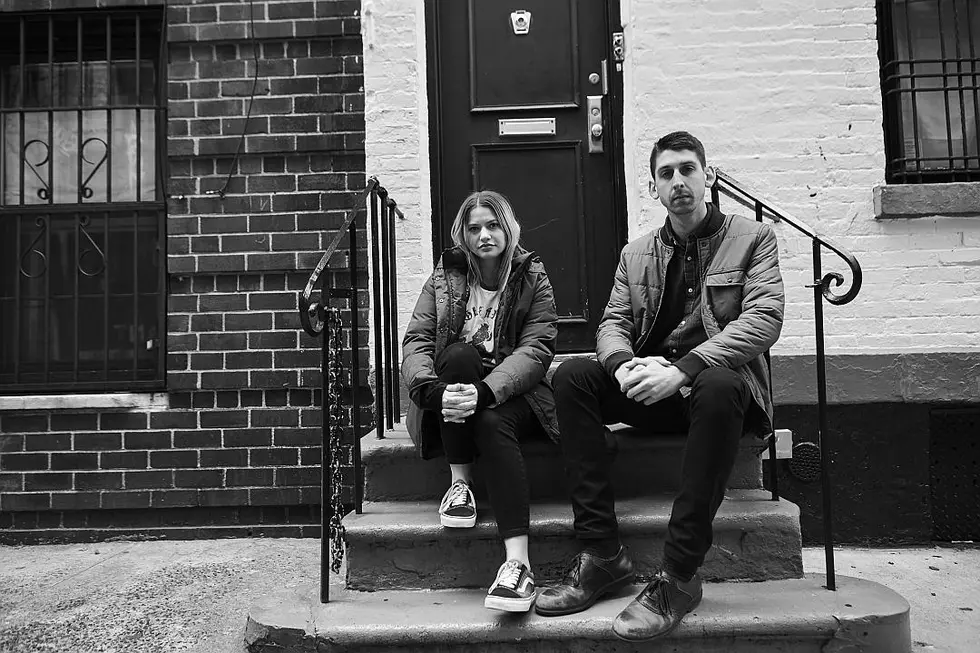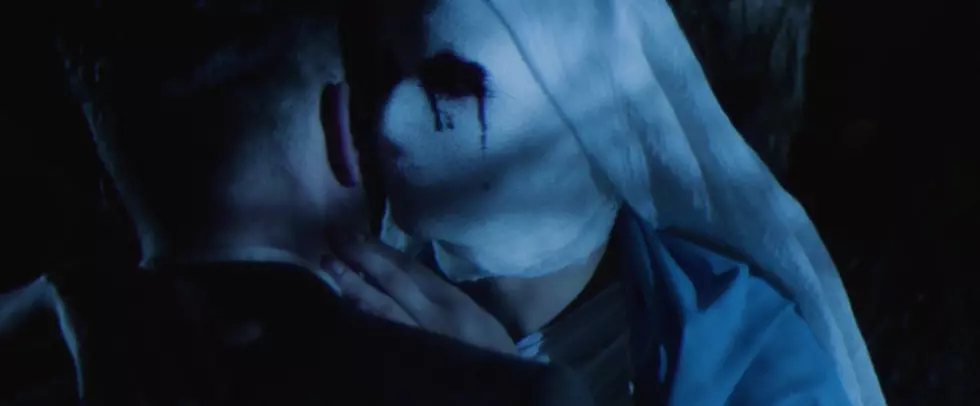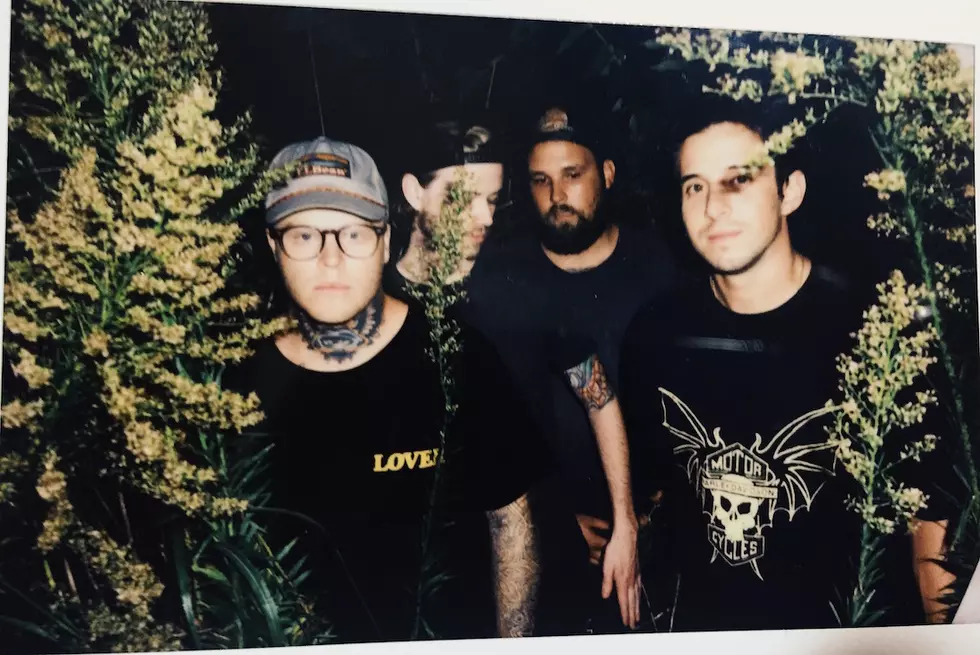
Earth’s Dylan Carlson and the Bug’s Kevin Martin on Collaboration, Los Angeles and Experimentation
Listening to Concrete Desert, the full-length collaboration between the Bug and Earth, one thing slowly becomes clear: This is a bona fide collaboration. Dylan Carlson’s work with Earth over the decades has led to an abundance of sprawling, brooding, guitar-centric music. Kevin Martin’s work as the Bug has pushed rhythms and experimentation to the forefront, creating music that you can dance to even as it leaves you thoroughly disoriented.
The two initially collaborated on a 12” in 2014, with artwork by Simon Fowler. From there, the duo reteamed in a Los Angeles studio; the resulting album is as ominous as anything that Carlson has made, and as inventive as anything Martin has done. I talked with them about the way that they collaborated, their impressions of Los Angeles and the literary figures whose work inspired parts of the new Ninja Tune album.
What was the genesis of the two of you working together?
Dylan Carlson: I think it was Kevin’s idea. We initially hooked up courtesy of Simon Fowler and then, I guess, I mean, Kevin was pleased with the results — I’m assuming from the 12”s — and suggested we do a full-length. And then we had an opportunity to work together in L.A.
Kevin Martin: I was basically a fanboy of Dylan’s for a long time. I really liked Earth records for a very long time, going back to when I first heard Earth 2, and I didn’t know what the fuck it was, and just my jaw hit the floor, and I wasn’t even sure I liked it at first when I first listened, but then it became a part of me. And basically, [I] had a conversation with Simon about Dylan’s work and said, “I’d like to work with Dylan,” and that’s how the first 12” came about. And like Dylan said, I was very happy with the results of the 12”, you know? And the feedback was even more than expected, actually. So, as we were going to be in the States at the same time, and I was going to have some time off in L.A. for the first time, I thought I’d pop the question to Dylan and see if he’d show me some mercy.
Was the working process for the full-length any different than it was for the 12”? Or did that experience help shape the process?
DC: Kevin had a bunch of tracks that he had worked on. This time, I was able to come into the studio, and we were actually both in the same place. [Laughs] Whereas on the 12”s, I had just sent him some guitar tracks. He had sent me the files and I had recorded the guitar and sent them back, whereas this time it was much, much nicer. It was nice to be in the studio and get feedback and stuff.
KM: I’d agree with Dylan wholeheartedly. When we were in the process of the album recording sessions, it’s just nice to get to know Dylan better, you know? And get to know his playing better. Of course, I’d been aware of his eclectic nature through the records that Earth had made previously, but to be able to bond over them and the influence and inspirations — and to be able to talk about potential directions for the record — was crucial.
And in all honesty, the schedules that Dylan played changed dramatically by the time the record was mixed down, because how I work is very reactive, and hearing what Dylan put down then made me rethink the original backing tracks that I’d sketched out. I mean, they were very much loose sketches, you know? I sketched them in Brazil, where I’d played just prior to getting the flight up to L.A., and was sketching them having very little sleep in L.A., just working all night on these sessions. Basically absorbing in the daytime and then reflecting that in sound sketches in all-night sessions in the Airbnb I’d been stuck in.
So, for me, it was great to be able to work with Dylan and just, you know, get to know him as a person. In a way, I think the album’s really a journey, you know? For me, it’s very reflective of how I felt about L.A. and about America, but also reflective of a growing friendship with Dylan, and just a growing awareness of how to bring two disparate worlds together sonically.
DC: That was interesting for me, having lived in L.A. and had more experience in L.A., but then filming your reactions to L.A. and, like, having had some of the same reactions to L.A. So, yeah, it was definitely a real reaction to the environment …
KM: I think Dylan really helped shed some light on the alienation I felt in that city. I’d never been particularly drawn to L.A. in my previous visits, but they’d been very fleeting visits. But just literally walking around the city, as nobody does, was a big eye-opener, you know? And just to see — for me, L.A., just by the fact it’s the center of Hollywood, it’s the center of an American fantasy, as far as I’m concerned. And just seeing the disparate nature of how people exist and certainly don’t seem to coexist, you know? There just seems to be people who exist in their own realm and very much ignore other people in other realms. You know, I was pretty stunned by how many homeless people I’d stumbled across, like in mini-cities within cities. It was shocking to see so much wealth and so much complete poverty on the doorstep of one another, and just zero interaction or reaction. And also racially. I personally felt that I met a lot of white hipsters in L.A., but I didn’t see a lot of cultural interaction at all. Considering America is a country based on immigrants, much to Trump’s displeasure. Where is the integration between the different cultures in America? It’s something that’s always stunned me since the first time I ever set foot in the States and in New York. Trust me, London is far, far from perfect and riddled with racism, but there is a basic integration. My neighbors were Pakistani, Indian, Jamaican, Turkish, and I interacted with those people and loved doing it.
DC: I’m totally blown away every time I come back to the States from London. I mean, it really took being married to an English girl and living in London part of the time and, like, seeing how truly multicultural it is. Every time I come back to the States, I’m just blown away by how segregated and backwards America is in that regard. It’s almost embarrassing to realize how backwards America is in that respect. But yeah. Then, like you said, L.A. is — even though it’s full of very different ethnic groups — like you said, it’s a super-segregated city.
KM: Also it’s, just for me, it was just in the fallout. America is the land of dreams for so many people from so many different countries who gravitate towards it to fulfill their dreams and to escape harsh realities from elsewhere. But the reality of America is so different from that dream. The American Dream is just riddled with fallout, you know? And like I said to you in the studio, what really struck me is there’s no safety net at all in America. You are fucked if you don’t have insurance. You’re not going to get seen in the hospital. Very shocking to me, you know? Very shocking how money speaks louder than anything in the States. It’s the same everywhere now, but it’s just blatant in America to me.
Did you notice there were certain ways that your observations about L.A. were tangibly shaping — or reshaping — the music you were making as you were in the studio?
KM: I’d known that when it looked like there was going to be enough time to make an album with Dylan. I’d been really inspired by the idea of doing the album with Dylan, and I’d made a lot more sketches than I’d realized was even possible myself. And it was very much with Dylan in mind and Dylan’s view of America, because Dylan’s style of guitar and the most recent Earth records, for me, were actually incredibly positive records. I don’t see them as doomy at all; I see them as really expansive and kaleidoscopic, and just a sort of picture of America that seems nostalgic for a good America, you know? In my head. I guess I fought with long shadows. [Laughs]
DC: You brought the darkness and I brought the light. [Laughs]
Were there things about each of you that sort of surprised the other, based on your knowledge of one another before this?
DC: We bonded over Velvet Underground appreciation, and ...
KM: Spacemen 3, dub.
DC: Yeah, dub.
KM: We just don’t talk about guitars a lot.
DC: Kevin has to get over his guitarphobia. [Laughs] Even though I’m a guitarist, I can understand it. But yeah, we just realized there are certain touchstones that we share.
KM: I think we both basically gravitate towards slow and minimal, in a way, and the use of space in deployment of sound where the space is as important — if not more important — than the sound that’s used. Until I’d spoken with Dylan in the studio, it was all supposition with me. I never really knew what Dylan was into. I hadn’t read it. Which is weird for me, because I’m normally a complete addict for reading interviews and music trivia. I hadn’t actually read any interviews with Dylan, which is bizarre. I don’t know why or how. So, I didn’t really know where his musical roots were, you know? I’d heard that he liked some King Midas Sound stuff, so I guessed he may like dub music.
When I first approached him, he was suggesting that maybe I at some point do dub mixes of some of the Earth stuff. So, then I supposed, yeah, Dylan’s got knowledge of dub that’s deep. Although I like the idea of dubbing out mixes that we’re working on now more than looking backwards. I think X plus Y equals Zed with this album, because what Dylan laid down in the States, again, I was just mad impressed by how emotive his playing is and how melancholy, in a really touching way — or how beautiful in a really arresting way — his playing can be. And also, it swung. There’s real swing to Dylan’s playing. So, when I came back to Berlin, suddenly I developed this newer sound and I’d even played to him in the studio where I’d had this idea of this really fuzzed-out jazz. And I started incorporating hardcore double bass elements, but heavily processed just to accentuate this idea of this dirty, sleazy jazz.
I think it was a very reactive making of the weapon. It was unusual. It wasn’t like a normal rock band where you have your parts in place, you go to a studio, you have your songs ready. This album has morphed continuously, and that’s the beauty of it for me, and that’s why personally I love studios, you know? That’s why I fell in love with the idea of studio alchemy.
DC: The thing I like, too, is the way that the music grows afterwards. It’s not set in stone when the session is done, and then I get to hear what Kevin’s done. And it’s cool now because we’re getting to develop it more in a live setting as well.
KM: Yeah, the live thing really took off at the last show, we felt, because we had a context. Previously, I felt it’d been a bit of a fumbling area, where it was almost like two boxers in a ring just jabbing at each other. But this was full combat at the last show, and it sounded fantastic because we had the album as a basis and foundation to move again from. And I said to Dylan, after that last show, that in a way it’s almost a shame that we hadn’t waited until now to make the album, because it was so deep in terms of how it would sound having done the live show.
Both of you have been making music for a long time. How do you find the balance where this truly is a collaboration?
KM: Graciously, Dylan suggested that I just do what I feel is best with the recordings. And that was very flattering that he trusted me to do that. Dylan doesn’t have to be in my studio to be all over the record in terms of his presence and his tone and what he brings to the record. Dylan’s a craftsman in the way that I’m trying to be a craftsman at the studio. Although I personally feel — and I imagine — that Dylan makes the final decisions in Earth, I guess he’s left me to make final mixing decisions in our collaboration. And so far he hasn’t rejected them. If Dylan said he didn’t want anything, of course, I’d redo it. If he wasn’t happy with what I sent him, I’d be the first to redo it because that’s the whole point of collaborating with someone: Are they happy? Ultimately, we both want to feel that it’s representative of some chemistry between us.
DC: I’m not a studio person. When I collaborate with people, I collaborate and I know what I’m good at and I know what they’re good at. And so, I think if we both do our things that we’re good at, you’re going to get the best results. And since I’m not, like, a studio guy, that’s sort of why now Kevin’s going to do his thing. I’ve always approached our plan from, like — I mean, guitar players that I really admire, or like, you know, Cornell Dupree, J.J. Cale, Steve Cropper, like the old R&B kind of guys: They’re serving the song. It’s just like crafting a hook and a groove and something interesting, but that instills the song.
There are certain records that are what I call “guitar player records,” where they’re great records, but they’re really only of interest to other guitarists. I don’t make records like that. I make records for everybody, I hope. And so, to me, serving the song is the important part, rather than me getting my licks in or showing off.
KM: This record’s been quite a hindsight record for me. I see a lot of patterns develop during the making of it after the fact. And for me, when Dylan and I talked about film scores, you know, and the use of film narrative and the way a lot of film music benefits from not actually being blatant, being quite subtle and just informing an idea rather than stating an idea sonically. And I think, in a way, there’s a really very cinematic feel to this album. Which we didn’t discuss before at all. In a way, having a narrative conceptually helps me musically think through records. Many years ago, I’d just be experimenting for the fuck of it and see what happened, whereas now I know it helps me a lot more to have some idea of why the fuck I’m trying to make a record and what it’s trying to say sonically and narratively.
DC: I think that something we both share is this idea that both the songs and the albums should all have arcs. And no matter how vague that it may be, it’s the idea of a narrative journey within each song, and with the arc of the album as well. To me, that’s what separates the great albums from the not-great albums: With the great albums, each song is great, and then the way they’re arranged is great and the flow of the record is an arc.
Is wanting to have an arc where the title of the record came from?
KM: It was just ... maybe even in the studio, I suggested it to Dylan.
DC: You did. And then I was telling you about that author, Mike Davis. [His book] City of Quartz is all about the water situation and how L.A. is built where there isn’t enough water to support the population and whatnot.
KM: I’d been a long-term fan of a writer called J.G. Ballard who’d always had great dystopian views of urban life. And they had also reflected that feel for me, too.
DC: Something else we both shared was J.G. Ballard.
KM: I once met him. I don’t know if I told you, Dylan, but I was too shy to go say hello to him, and my ex-girlfriend at the time took the book that had just been released to get him to sign it, and then told him that I was in a band. I’d given her a cassette of my band at the time, called God, and it was a rehearsal tape recorded on a mic in a basement squat. So, tortuous noise to discuss. I wouldn’t want to hear it myself. I remember a year or two later, a friend said, “Have you bought the new, updated version of The Atrocity Exhibition? Or seen it?” And I was like, “Nah.” He said, “Because you’re mentioned in it.” “Oh, what the fuck?” And in the book he said, “At a recent book signing, I had the pleasure to meet the voice of God.” He described it as a London pop band. Which is just genius. I’m very much a devoted reader of J.G. Ballard. I think he was — the term “genius” gets bandied around a lot, but for me he actually literally was.
More From CLRVYNT









